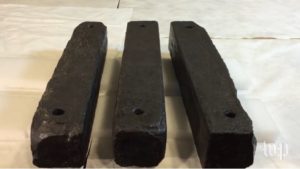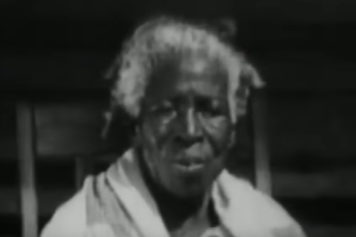
Some of the iron ballast bars that were shipped to the U.S. to be displayed at the Smithsonian National Museum of African American History and Culture. Photo courtesy of the Washington Post
As the Smithsonian National Museum of African-American History and Culture gears up for its grand opening in September, curators at the museum are working to put together a rare exhibit featuring relics from a sunken Portuguese slave ship.
According to the Washington Post, four cast-iron ballast bars from the São José Paquete de Africa slave ship were delivered in a wooden crate to the African-American history museum Wednesday morning. The Portuguese vessel, traveling from Mozambique Island to the northern coast of Brazil with nearly 500 captives on board, was blown into rough waters and impaled on rocks near the Dutch settlement of Capetown, South Africa in the late 1700s.
Two hundred and twelve slaves drowned in the wreck, along with the sacred ballast bars, which were often used to compensate for the relatively light weight of human cargo, the Washington Post reports. It wasn’t until 2014 that the bars were recovered from the bottom of the ocean. Now the relics are set to go on display when the museum opens in September.
“As far as we know, this is the first archaeologically documented wreck of a ship that was carrying enslaved Africans,” Paul Gardullo, museum curator with the National Museum of African American History and Culture, said Wednesday.
Dark brown and oblong in shape, each ballast bar weighed about 88 pounds, the publication reports. They’re currently on a 10-year loan from Cape Town’s Iziko Museums.
“These blocks were with the slaves,” said Jaco Boshoff, the South African marine archaeologist from Iziko Museums who helped re-surface the relics. “Although we haven’t found human remains — [and] there’s an expectation that we might do that — we will find them trapped under something like a ballast block.”
For Gardullo, the heavy bars serve as a reminder of the 400-year global trade that enslaved and commodified Black bodies for use in the Western world. According to the Gilder Lehrman Institute of American History, some 12.5 million slaves had been shipped from Africa and brought to the Americas.
“This is an incredibly profound moment. These things are heavy,” Gardullo told Washington’s WJLA as he helped lift one of the pieces out of a wooden box. “As Jaco mentioned, they are heavy physically, but they’re heavy emotionally.”
“An object like this makes it very tangible, makes it very real, makes it very personal and human,” he continued.
The relics will be displayed at the new Smithsonian museum alongside 34,000 other artifacts, including a railroad passenger car dating back to the Jim Crow Era; abolitionist William Lloyd Garrison’s traveling trunk; Nat Turner’s Bible; and a variety of other rare objects that curators have collected, Smithsonian Mag reports.
President Barack Obama will cut the ribbon at the museum’s opening ceremony on Sept. 24.
“In a few short months visitors will walk through the doors of the museum and see that it is a place for all people,” the museum’s founding director, Lonnie Bunch, said in a statement. “We are prepared to offer exhibitions and programs to unite and capture the attention of millions of people worldwide. It will be a place where everyone can explore the story of America through the lens of the African-American experience.”


